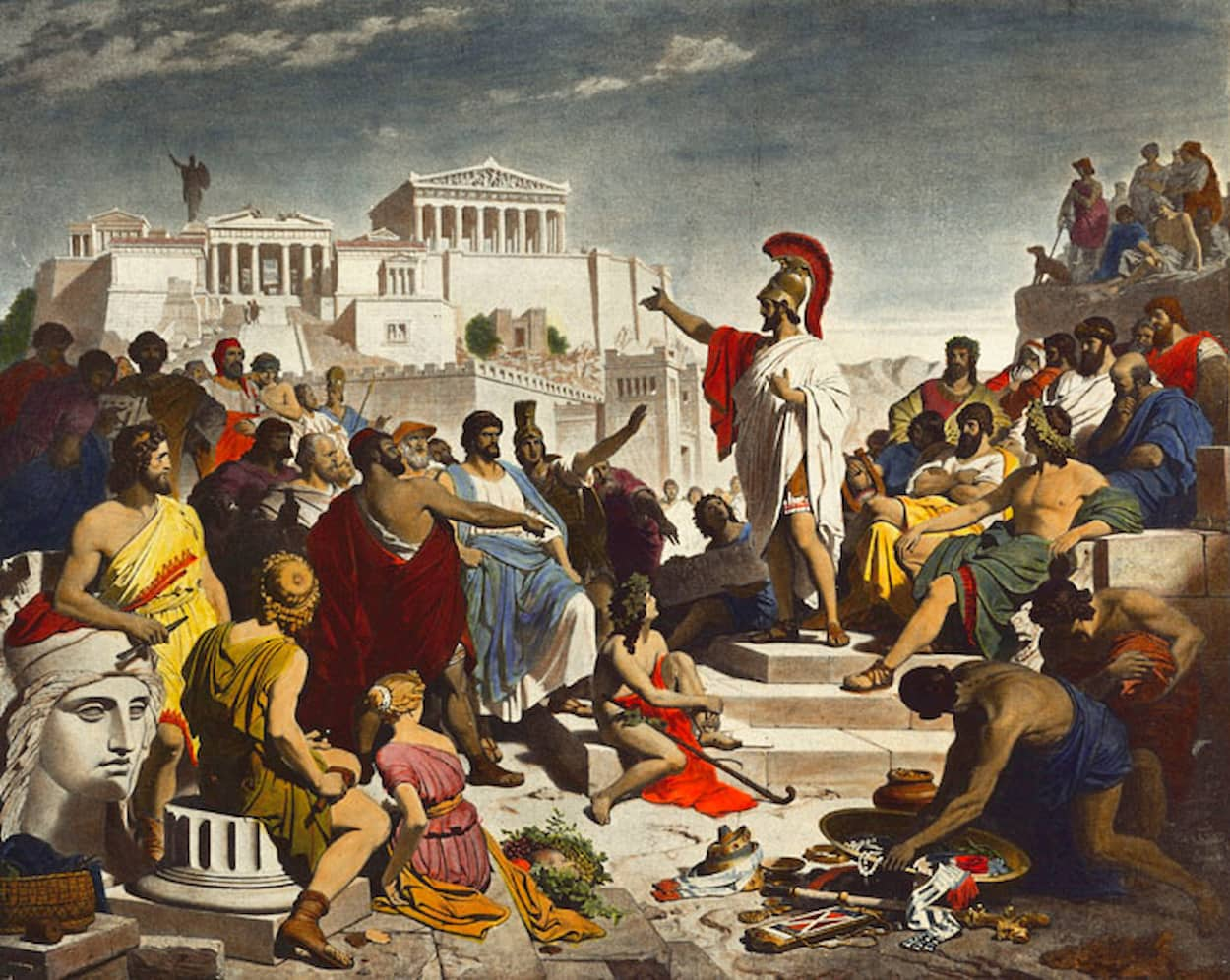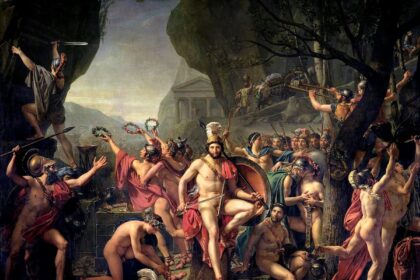Archaic Greece, which emerged from the “dark decades” shortly after Classical Greece, saw profound transformations throughout this era. Several new developments emerged, including the development of writing, an increase in population, and the emergence of urban centers (polis). A city was defined as an “autonomous state with a relatively modest area (chôra), centered on a town where the administrative authorities were located, and which was embodied in the community of citizens (politai).” In the seventh and sixth centuries BC, these latter ones created a new body of amée, the hoplites, who would become the backbone of the armies of the Greek towns, especially Athens, Sparta, and Syracuse.
The situation at the beginning of archaic time
According to the synoecism scenario, this birth took place in the eighth century, and it involved a cluster of communities, one of which gradually became dominant. This urbanization process was mediated by the Greek colony that began in the eighth century. Southern Italy, Sicily, and the Black Sea coast were the three primary locations. It didn’t take long for the Greek cities to begin fighting one another after their appearance.
An aristocracy, a social class made up of noble individuals, arose at the end of the Geometric period, which occurred between approximately 900 and 750 BC. Archaeological excavations at the Euboean site of Lefkandi have uncovered the home of a warrior who was buried with his weapons around the years 1000 or 950 BC. This suggests that one of the foundations of ancient Greece’s ruling class was an aristocracy of soldiers.
The Homeric wars, as depicted in ancient Greek literature, were chaotic conflicts characterized by individual heroes dueling and foot troops clashing. The heroic encounter was based on the bravery and strength of a few brave and solitary people who faced down a whole army. According to archaeological excavations, the graves of the soldiers who fought in these wars were constructed in the eighth century. The famous Argive tomb, which dates to this period, depicts a significant change in the style of armor and swords. Horses were more of a symbol of prestige than a practical weapon, and were used mostly for formal occasions such as sporting events and funerals. Aristocrats, the ruling class of ancient Greece, often chose to use horses on these occasions.
When going to war in ancient Greece, only foot soldiers were deployed; neither chariots nor cavalry were used. As previously noted, owning a horse was a way to show that an individual belonged to an exclusive group of people. It was not expected that a horse would be used in combat, but rather that it would provide more freedom of movement and more options in battle. Owning a horse was a sign of social standing, but not necessarily military effectiveness, as aristocrats were considered knights rather than riders.
The Hoplite Reform: A revolution
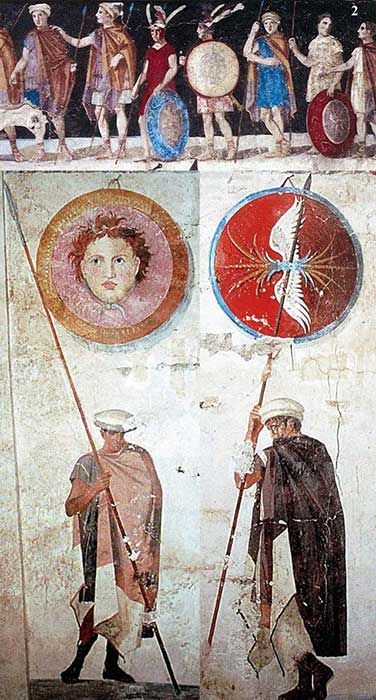
The eighth century saw the apex of combat aristocracy, but its legitimacy was called into question by the early modern period.
To be a member of a lineage (a genos) was crucial in ancient aristocracies, such as the Alcmaeonidae in Ancient Athens, because the aristocracy was defined as the governance of the best (aristoi). There were also specific groups known as the Geomores (“keepers of the grounds”) in Syracuse (Sicily), the Eupatrides (“those who have good ancestors”) in Athens, and the Hippeus (“breeders of horses”) in Euboea.
Slaves, who were not free, made up a growing segment of ancient Greek society, whereas free men (peasants and craftsmen) were not aristocrats and did not have access to political life.
Thus, the aristocracy was defined by its riches, political power, judicial authority (they dispensed justice since they were the only ones who knew the law, which was oral and not written), and religious power (they controlled the cults of the city; the priests belonged in a hereditary way to an aristocratic family). To conclude, they enjoyed a lot of ceremonial rather than practical benefits. Due to this, we can see why there was no feudal structure in place at the time.
When the hoplite reform finally got underway, we saw a whole new style of fighting wars. Between 700 and 650 BC, the first Greek city-state wars erupted. This includes conflicts like the Trojan War fought between Chalcis and Eretria and the later capture of Messinia by Sparta (Laconia). The hoplite reform took place between 700 and 650 years before the Common Era. The appearance of hoplites, heavily armed infantrymen, translated this concept most directly. Hoplites would wear a helmet, cuirass, knemides (leggings), a round shield (hoplon) of about 1 meter in diameter, and two grips on its internal face for offensive and defensive purposes (an armband and a handle).
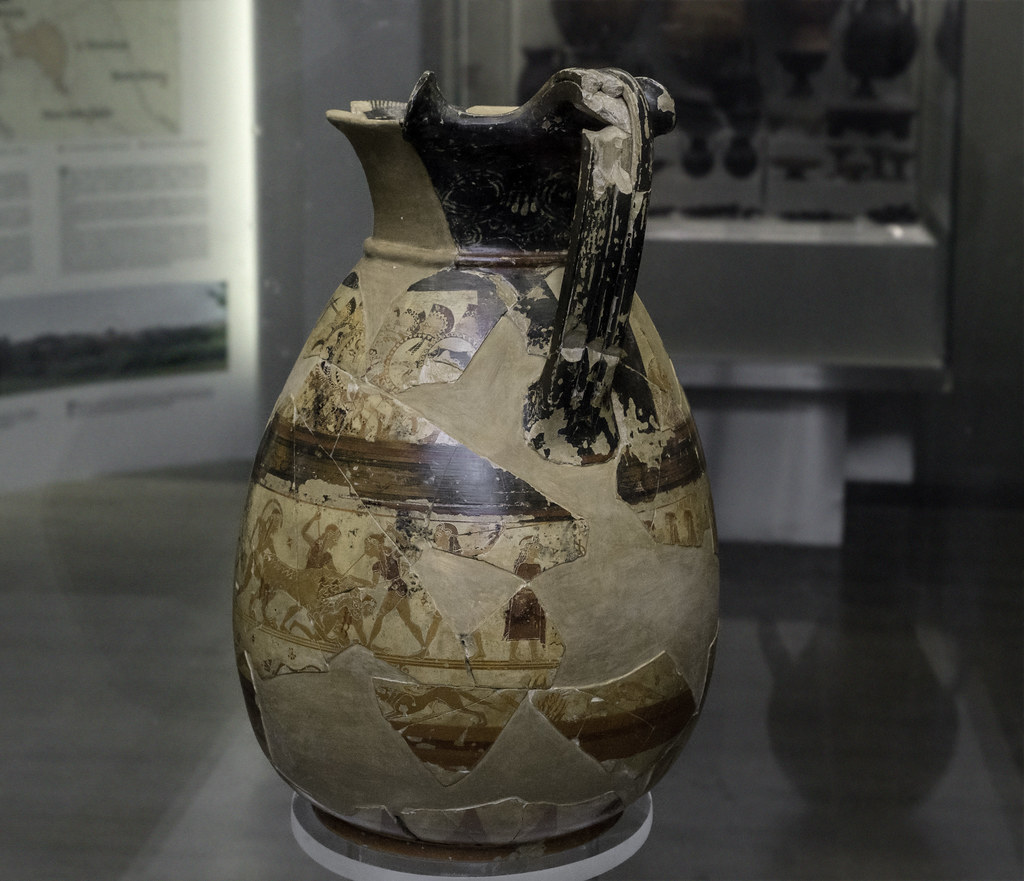
The hoplites deployed into battle in a configuration known as the phalanx, which consisted of seven or eight rows of aligned fighters. The round shield served as the basis for its design. This shield was useless to a solitary warrior but became invaluable when used as part of a phalanx. When forming a phalanx, the soldiers had to stand together as one. Phalanxes have only recently been shown in art, with the earliest example coming from the Chigi vase (above), which was created between AD 650 and AD 620. The Aulete provided the tempo (the flute player was located behind the hoplites).
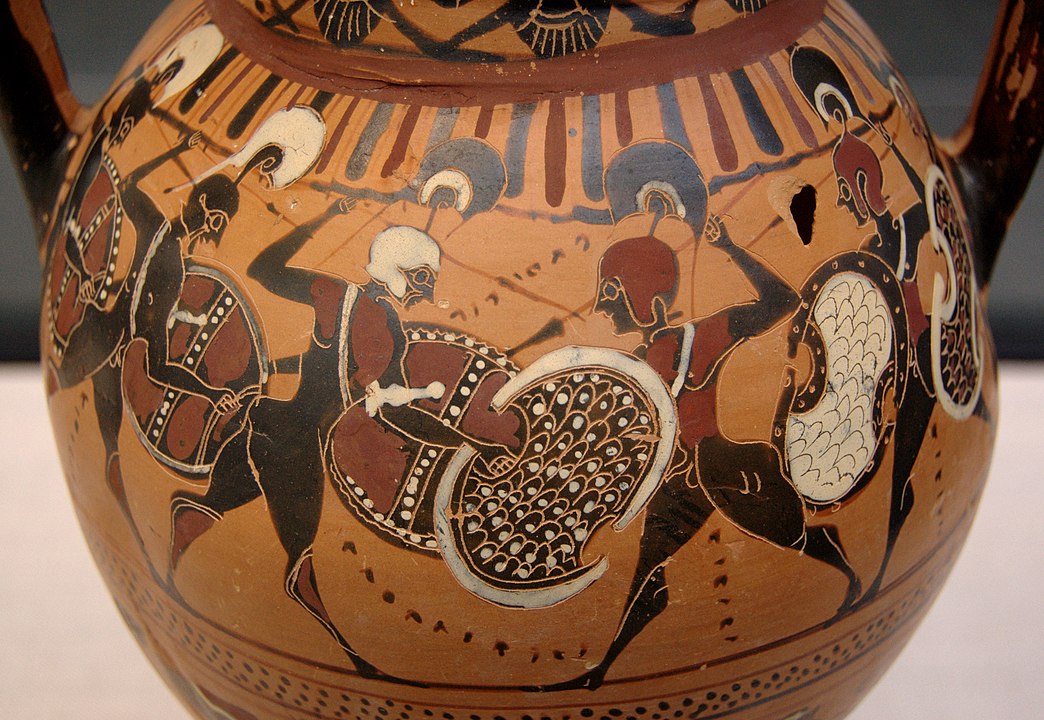
The phalanx prioritized patriotism and held the beauty of death in the highest regard. One did not utilize jet weapons because using them was seen as a sign of weakness; instead, one chose to meet one’s opponent head-on, adhered to group norms of conduct, and demonstrated bravery. In fact, there was a lack of willingness to give in to fear of death or defeat. The soldier had to bring back the shield; failing to do so would bring shame and label him a traitor. As a result, the ideals were inspired by the citizen-soldier. Typically, war occurred during the warmer months.
Conflict was formalized into rules. The thrust was studied first, then the melee, and finally the prize was taken home. Both opposing forces had to agree on which side deserved victory, and the victor would be the side that survived the conflict with the fewest casualties. Using a time-honored ritual, he raised a trophy on the battlefield from the captured weapons of the vanquished. The victor also had to restore the bodies of the dead to the losers. Someone from the losing side had to go in and arrange the return of the bodies.
In many ways, the hoplitic wars were reminiscent of the Greek agôn (a kind of contest, a sporting event).
The evolution of the Greek city under the pressure of war
The basic principle was that the warrior had to fork out his own cash for the pricey gear he needed to succeed in battle. This restricted the kind of people who could be recruited as hoplites due to social norms. Due to the hoplitic reform, there were now more soldiers (the aristocrats were no longer enough). Thus, the combatants were drawn from the ranks of the prosperous farmers who could afford to equip themselves with a panoply. They were zeugites, affluent farmers who drove around in labout carriages. The free males, who were known as “thetes,” were those who were too impoverished to afford the hoplitic panoply.
In exchange for their defense of the city, the Zeugites wanted an equal share of political authority with the aristocracy. As the status quo of aristocratic rule came under scrutiny, a new form resembling the rule of a tyrant emerged (note that the qualifier “tyrant” did not have a negative value for the Greeks of the time). To put it simply, a tyrant was an aristocracy that had taken over a country in a coup d’état and ruled like a monarch. Many Greeks saw him as a representative of a monarchy that was not legitimate.

There was a world of difference between a commerce ship and a warship. Merchant ships used sails, while warships used oars. Their attacking prowess was shown by the spur that was fastened to the bow. The 50 oarsmen that powered the Penteconter made it an ancient warship. In the early sixth century, cities such as Corinth, Samos, and Aegina emerged as maritime powers.
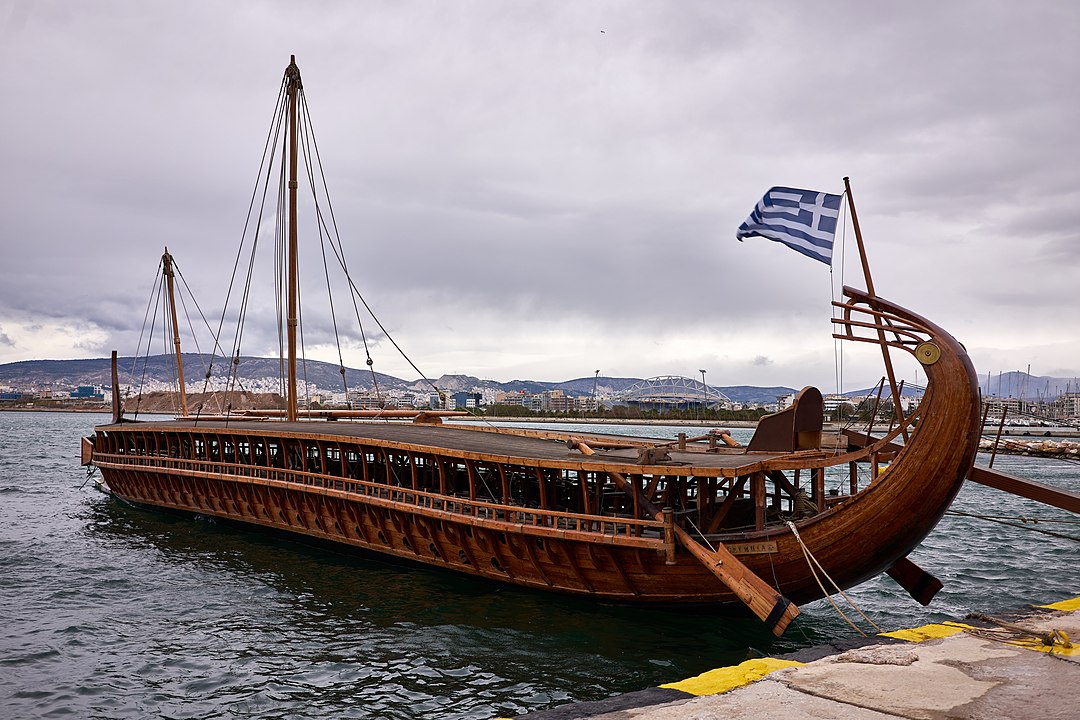
A new warship, the trireme, with 160 oarsmen in three stacked rows (see the figure above, a reconstruction of the trireme, the Olympias), was developed in Corinth and Samos, making them the birthplace of a new technological development in naval strength. As a result of this breakthrough, port communities quickly found themselves in need of a large number of crew members. The majority of the rowers weren’t slaves, but rather free people (the thetes) who couldn’t afford the hoplite panoply and had to rely on their own clothing and tools to get the job done. The impoverished citizens were rallied to fight, and the thetes eventually came to demand a share of political authority for themselves.
War and civilization were inextricably connected in ancient times. The hoplite, a new breed of soldier, emerged in the eighth century. The hoplite was more effective than a regular soldier thanks to technological advancements and the new ideals they represented. This innovation, which spread across Greece, was significant; nonetheless, it was at Sparta where the highest levels of achievement in this regard can be seen.
Hoplite ideals of honor and duty serve as an example for patriots of all eras. Combat had changed throughout the years as technology advanced, necessitating the recruitment of additional warriors. This gave rise to the problem of the aristocracy having all the political power. This was the beginning of the democratization process that was underway.
Bibliography:
- Fink, Dennis (2014). The Battle of Marathon in Scholarship: Research, Theories and Controversies Since 1850 (illustrated ed.). McFarland. p. 32. ISBN 9780786479733.
- Gradualism | The Hoplite Battle Experience”. sites.psu.edu. Retrieved 2016-11-30.
- Kagan, Donald (2013). Men of Bronze: Hoplite Warfare in Ancient Greece. Princeton University Press. p. 8.
- Sage, Michael M (1996). Warfare in Ancient Greece: A Sourcebook. London, GBR: Routledge. p. 281.
- G. H. Smith (2010). A Manual Of Grecian Antiquities: Being A Compendious Account Of The Manners And Customs Of The Ancient Greeks(1832). Kessinger Publishing. p. 170. ISBN 978-1164537380.





